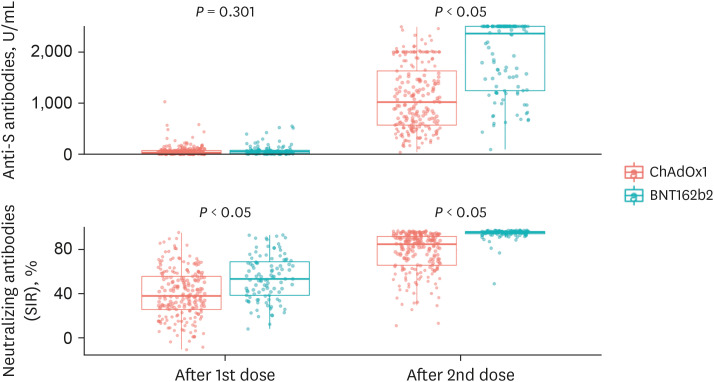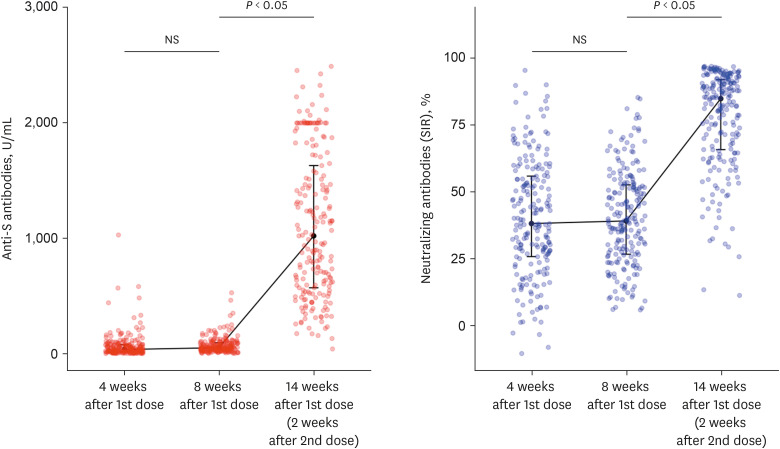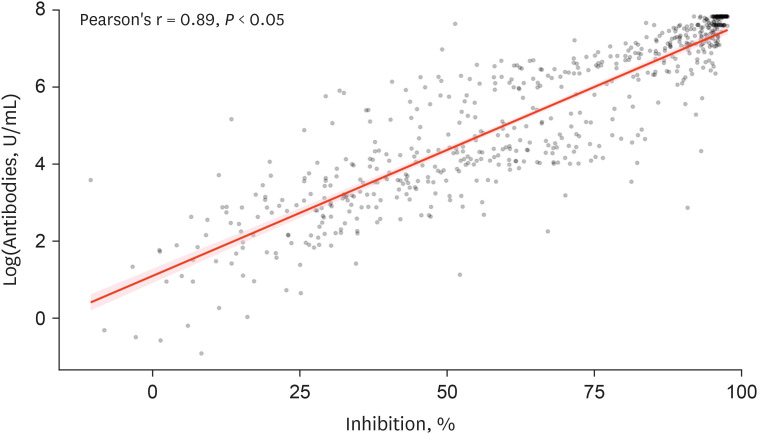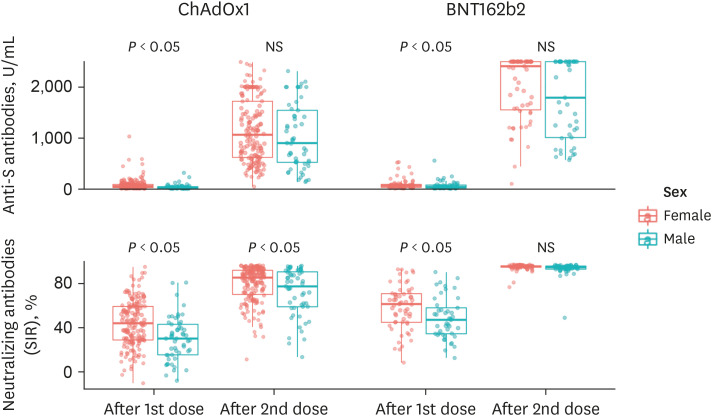J Korean Med Sci.
2021 Nov;36(46):e311. 10.3346/jkms.2021.36.e311.
Comparison of Antibody Response Elicited by ChAdOx1 and BNT162b2 COVID-19 Vaccine
- Affiliations
-
- 1Division of Infectious Diseases, Department of Internal Medicine, Myongji Hospital, Goyang, Korea
- 2Seegene Medical Foundation, Seoul, Korea
- 3Department of Laboratory Medicine, Myongji Hospital, Goyang, Korea
- 4Department of Pediatrics, Myongji Hospital, Goyang, Korea
- KMID: 2522886
- DOI: http://doi.org/10.3346/jkms.2021.36.e311
Abstract
- Background
ChAdOx1 and BNT162b2 vaccines are currently commonly used against coronavirus disease 2019 worldwide. Our study was designed to determine the serostatus and relative levels of anti-S and neutralizing antibodies in patients who were administered either ChAdOx1 or BNT162b2 vaccine. In addition, we investigated whether the antibody response to each vaccine differed according to sex and age.
Methods
Healthcare workers (HCWs) at a general hospital who were vaccinated with two doses of either ChAdOx1 or BNT162b2 were invited to participate in this prospective cohort study. Blood samples of HCWs vaccinated with both ChAdOx1 doses over a period of 12 weeks were collected at weeks 4 and 8 post first vaccination and 2 weeks post second vaccination. Blood samples of HCWs vaccinated with BNT162b2 were collected in the third week after the first dose, and the second dose was then administered on the same day; two weeks post second dose (5 weeks after the first dose), blood samples were collected to assess the antibody response. The titers of anti-S antibodies against the severe acute respiratory syndrome coronavirus 2 spike (S) protein receptor-binding domain and the neutralizing antibodies in the collected blood were evaluated.
Results
Of the 309 HCWs enrolled in the study, 205 received ChAdOx1 and 104 received BNT162b2. Blood samples from participants receiving either the ChAdOx1 or BNT162b2 vaccine exhibited substantial anti-S and neutralizing antibody seropositivity subsequent to the second dose. All participants (100%) from both vaccine groups were seropositive for anti-S antibody, while 98% (201/205) of ChAdOx1-vaccinated individuals and 100% (104/104) of BNT162b2-vaccinated individuals were seropositive for neutralizing antibodies. The median levels of anti-S and neutralizing antibodies were significantly higher in the BNT162b2-vaccinated group than the ChAdOx1-vaccinated group; in particular, anti-S antibody titers of 1,020 (interquartile range, 571.0–1,631.0) U/mL vs. 2,360 (1,243–2,500) U/mL, P < 0.05, were recorded for the ChAdOx1 and BNT162b2 groups, respectively, and neutralizing antibody titers of 85.0 (65.9–92.1%) vs. 95.8 (94.4–96.6%), P < 0.05, were recorded for the ChAdOx1 and BNT162b2 groups, respectively. In the ChAdOx1 vaccine group, the neutralizing antibody level was significantly higher in women than in men (85.7 [70.3–92.5%] vs. 77.7 [59.2–91.0%], P < 0.05); however, the neutralizing antibody titer in the BNT162b2 vaccine group did not vary between the two sexes (95.9 [95.2–96.6%] vs. 95.2 [93.5–96.3%], P = 0.200). Analysis of the correlation of antibody profiles with age revealed that the levels of anti-S antibodies and signal inhibition rate (SIR) of neutralizing antibodies decreased significantly with age.
Conclusion
Both the ChAdOx1- and BNT162b2-vaccinated groups showed high seropositivity for anti-S and neutralizing antibodies. The SIR of neutralizing antibodies in the ChAdOx1 vaccine group was higher in women than in men. Enhanced antibody responses were observed in participants vaccinated with BNT162b2 compared to those vaccinated with the ChAdOx1 vaccine.
Keyword
Figure
Reference
-
1. Polack FP, Thomas SJ, Kitchin N, Absalon J, Gurtman A, Lockhart S, et al. Safety and efficacy of the BNT162b2 mRNA COVID-19 vaccine. N Engl J Med. 2020; 383(27):2603–2615. PMID: 33301246.
Article2. Folegatti PM, Ewer KJ, Aley PK, Angus B, Becker S, Belij-Rammerstorfer S, et al. Safety and immunogenicity of the ChAdOx1 nCoV-19 vaccine against SARS-CoV-2: a preliminary report of a phase 1/2, single-blind, randomised controlled trial. Lancet. 2020; 396(10249):467–478. PMID: 32702298.3. Ramasamy MN, Minassian AM, Ewer KJ, Flaxman AL, Folegatti PM, Owens DR, et al. Safety and immunogenicity of ChAdOx1 nCoV-19 vaccine administered in a prime-boost regimen in young and old adults (COV002): a single-blind, randomised, controlled, phase 2/3 trial. Lancet. 2021; 396(10267):1979–1993. PMID: 33220855.4. Walsh EE, Frenck RW Jr, Falsey AR, Kitchin N, Absalon J, Gurtman A, et al. Safety and immunogenicity of two RNA-based COVID-19 vaccine candidates. N Engl J Med. 2020; 383(25):2439–2450. PMID: 33053279.
Article5. Dagan N, Barda N, Kepten E, Miron O, Perchik S, Katz MA, et al. BNT162b2 mRNA COVID-19 vaccine in a nationwide mass vaccination setting. N Engl J Med. 2021; 384(15):1412–1423. PMID: 33626250.
Article6. Kim JY, Bae S, Park S, Kwon JS, Lim SY, Park JY, et al. Comparison of antibody and T cell responses induced by single doses of ChAdOx1 nCoV-19 and BNT162b2 vaccines. Immune Netw. 2021; 21(4):e29. PMID: 34522442.
Article7. Shrotri M, Fragasz E, Geismar C, Nguyen V, Beale S, Braithwaite I, et al. Spike-antibody responses following first and second doses of ChAdOx1 and BNT162b2 vaccines by age, gender, and clinical factors - a prospective community cohort study (Virus Watch). medRxiv. Forthcoming. 2021; DOI: 10.1101/2021.05.12.21257102.
Article8. Schwarz T, Tober-Lau P, Hillus D, Helbig ET, Lippert LJ, Thibeault C, et al. Delayed antibody and T-cell response to BNT162b2 vaccination in the elderly, Germany. Emerg Infect Dis. 2021; 27(8):2174–2178. PMID: 34102097.
Article9. Müller L, Andrée M, Moskorz W, Drexler I, Walotka L, Grothmann R, et al. Age-dependent immune response to the Biontech/Pfizer BNT162b2 COVID-19 vaccination. Clin Infect Dis. 2021; ciab381. PMID: 33906236.
Article10. Jung J. Preparing for the coronavirus disease (COVID-19) vaccination: evidence, plans, and implications. J Korean Med Sci. 2021; 36(7):e59. PMID: 33619920.
Article11. Korea Disease Control and Prevention Agency. Plan KNC-V. Updated 2021. Assessed February 2021. http://www.kdca.go.kr/index.es?sid=a3 .12. Campi-Azevedo AC, Peruhype-Magalhāes V, Coelho-Dos-Reis JG, Antonelli LR, Costa-Pereira C, Speziali E, et al. 17DD yellow fever revaccination and heightened long-term immunity in populations of disease-endemic areas, Brazil. Emerg Infect Dis. 2019; 25(8):1511–1521. PMID: 31298654.
Article13. Cohen BJ, Doblas D, Andrews N. Comparison of plaque reduction neutralisation test (PRNT) and measles virus-specific IgG ELISA for assessing immunogenicity of measles vaccination. Vaccine. 2008; 26(50):6392–6397. PMID: 18834911.
Article14. Eyal O, Olshevsky U, Lustig S, Paran N, Halevy M, Schneider P, et al. Development of a tissue-culture-based enzyme-immunoassay method for the quantitation of anti-vaccinia-neutralizing antibodies in human sera. J Virol Methods. 2005; 130(1-2):15–21. PMID: 16024096.
Article15. Tan CW, Chia WN, Qin X, Liu P, Chen MI, Tiu C, et al. A SARS-CoV-2 surrogate virus neutralization test based on antibody-mediated blockage of ACE2-spike protein-protein interaction. Nat Biotechnol. 2020; 38(9):1073–1078. PMID: 32704169.
Article16. Walls AC, Park YJ, Tortorici MA, Wall A, McGuire AT, Veesler D. Structure, function, and antigenicity of the SARS-CoV-2 spike glycoprotein. Cell. 2020; 181(2):281–292.e6. PMID: 32155444.
Article17. Dai L, Gao GF. Viral targets for vaccines against COVID-19. Nat Rev Immunol. 2021; 21(2):73–82. PMID: 33340022.
Article18. Salvatori G, Luberto L, Maffei M, Aurisicchio L, Roscilli G, Palombo F, et al. SARS-CoV-2 SPIKE PROTEIN: an optimal immunological target for vaccines. J Transl Med. 2020; 18(1):222. PMID: 32493510.
Article19. Buchholz UJ, Bukreyev A, Yang L, Lamirande EW, Murphy BR, Subbarao K, et al. Contributions of the structural proteins of severe acute respiratory syndrome coronavirus to protective immunity. Proc Natl Acad Sci U S A. 2004; 101(26):9804–9809. PMID: 15210961.
Article20. Traggiai E, Becker S, Subbarao K, Kolesnikova L, Uematsu Y, Gismondo MR, et al. An efficient method to make human monoclonal antibodies from memory B cells: potent neutralization of SARS coronavirus. Nat Med. 2004; 10(8):871–875. PMID: 15247913.
Article21. Huang WC, Zhou S, He X, Chiem K, Mabrouk MT, Nissly RH, et al. SARS-CoV-2 RBD neutralizing antibody induction is enhanced by particulate vaccination. Adv Mater. 2020; 32(50):e2005637. PMID: 33111375.
Article22. Khoury DS, Cromer D, Reynaldi A, Schlub TE, Wheatley AK, Juno JA, et al. Neutralizing antibody levels are highly predictive of immune protection from symptomatic SARS-CoV-2 infection. Nat Med. 2021; 27(7):1205–1211. PMID: 34002089.
Article23. Kim N, Minn D, Park S, Roh EY, Yoon JH, Park H, et al. Positivity of SARS-CoV-2 antibodies among Korean healthy healthcare workers 1 and 2 weeks after second dose of Pfizer-BioNTech vaccination. J Korean Med Sci. 2021; 36(21):e158. PMID: 34060264.
Article24. Earle KA, Ambrosino DM, Fiore-Gartland A, Goldblatt D, Gilbert PB, Siber GR, et al. Evidence for antibody as a protective correlate for COVID-19 vaccines. Vaccine. 2021; 39(32):4423–4428. PMID: 34210573.
Article25. Grzelak L, Temmam S, Planchais C, Demeret C, Tondeur L, Huon C, et al. A comparison of four serological assays for detecting anti-SARS-CoV-2 antibodies in human serum samples from different populations. Sci Transl Med. 2020; 12(559):eabc3103. PMID: 32817357.
Article26. Muecksch F, Wise H, Batchelor B, Squires M, Semple E, Richardson C, et al. Longitudinal serological analysis and neutralizing antibody levels in coronavirus disease 2019 convalescent patients. J Infect Dis. 2021; 223(3):389–398. PMID: 33140086.
Article27. Fischinger S, Boudreau CM, Butler AL, Streeck H, Alter G. Sex differences in vaccine-induced humoral immunity. Semin Immunopathol. 2019; 41(2):239–249. PMID: 30547182.
Article28. Klein SL, Flanagan KL. Sex differences in immune responses. Nat Rev Immunol. 2016; 16(10):626–638. PMID: 27546235.
Article29. Zimmermann P, Curtis N. Factors that influence the immune response to vaccination. Clin Microbiol Rev. 2019; 32(2):e00084-18. PMID: 30867162.
Article30. Bunders MJ, Altfeld M. Implications of sex differences in immunity for SARS-CoV-2 pathogenesis and design of therapeutic interventions. Immunity. 2020; 53(3):487–495. PMID: 32853545.
Article31. Giefing-Kröll C, Berger P, Lepperdinger G, Grubeck-Loebenstein B. How sex and age affect immune responses, susceptibility to infections, and response to vaccination. Aging Cell. 2015; 14(3):309–321. PMID: 25720438.
Article32. Takahashi T, Ellingson MK, Wong P, Israelow B, Lucas C, Klein J, et al. Sex differences in immune responses that underlie COVID-19 disease outcomes. Nature. 2020; 588(7837):315–320. PMID: 32846427.33. Flanagan KL, Fink AL, Plebanski M, Klein SL. Sex and gender differences in the outcomes of vaccination over the life course. Annu Rev Cell Dev Biol. 2017; 33(1):577–599. PMID: 28992436.
Article34. McCartney PR. Sex-based vaccine response in the context of COVID-19. J Obstet Gynecol Neonatal Nurs. 2020; 49(5):405–408.
Article
- Full Text Links
- Actions
-
Cited
- CITED
-
- Close
- Share
- Similar articles
-
- Comparison of antibody responses after the 1st and 2nd doses of COVID-19 vaccine with those of patients with mild or severe COVID-19
- Comparison of the rapidity of SARS-CoV-2 immune responses between primary and booster vaccination for COVID-19
- Comparison of Antibody and T Cell Responses Induced by Single Doses of ChAdOx1 nCoV-19 and BNT162b2 Vaccines
- Antibody Response Induced by Two Doses of ChAdOx1 nCoV-19, mRNA-1273, or BNT162b2 in Liver Transplant Recipients
- Changes in SARS-CoV-2 antibody titers 6 months after the booster dose of BNT162b2 COVID-19 vaccine among health care workers






